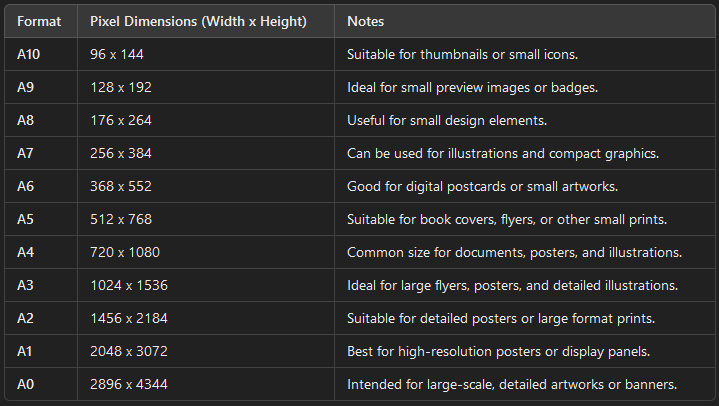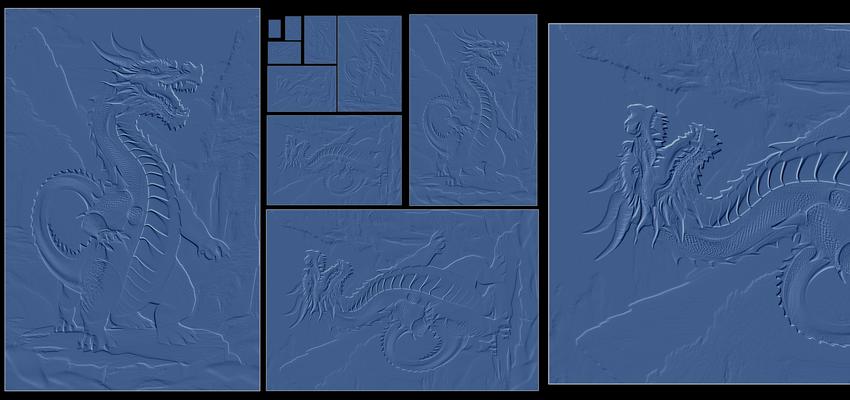"My idea was to implement A-series standards but also to keep pixel images in a practical ratio of 3:2 (landscape) or 2:3 (a portrait). My defined dimensions are based of 64x96 px (as the lowest image size). To correct some upscales I chose the closest to the given values. I used ChatGPT for minimal presentative format."
AI Generated Image Size Documentation (A-Series Paper Dimensions)
This documentation outlines the recommended pixel dimensions for generating images using AI models, following the A-series paper size standards. These dimensions ensure that the images maintain the correct aspect ratio (1:√2) and are suitable for print and digital formats, enabling seamless integration with physical and digital media.
1. Overview
The A-series paper sizes follow a consistent 1:√2 aspect ratio, which is ideal for maintaining proportion and scalability across different formats. When generating images using AI, it is crucial to use these dimensions to match real-world printing sizes, reducing the need for resizing and cropping.
2. Recommended Dimensions
The table below lists the pixel dimensions for each A-series format:

"Each value in pixel dimensions was considered and set by me. (putting an image here was my lazy choice)"
3. Best Practices for Image Generation
Aspect Ratio Maintenance: Ensure that the pixel dimensions used for image generation match the aspect ratios listed above to prevent distortions when scaling or printing.
Starting Size: For larger formats (A0, A1), it may be efficient to generate images at smaller sizes (like A3 or A4) and then use AI-based upscaling tools (e.g., Real-ESRGAN) for higher resolution outputs. This helps manage the model’s capabilities and retains image quality.
Performance Considerations: Smaller sizes (A10 to A5) are ideal for quick generation and low computational load, while larger formats (A3 to A0) may require tiling or more processing power, particularly for high-detail images.
Post-Processing: For larger images, use denoising and sharpening tools to enhance image details and quality after upscaling, ensuring the output remains sharp and visually consistent.
4. Use Cases
Small Formats (A10 - A6): Best for icons, badges, thumbnails, postcards, and other small design elements.
Medium Formats (A5 - A3): Suitable for digital artwork, posters, book covers, and flyers. These sizes are versatile for both digital displays and print.
Large Formats (A2 - A0): Ideal for high-resolution posters, banners, and professional artwork. These formats provide detail-rich images suitable for large prints or physical installations.
5. Limitations and Considerations
Model Constraints: AI models like Stable Diffusion 1.5 may have size limitations (typically around 1024x1024 pixels). For larger dimensions like A0 or A1, generate images at smaller sizes and upscale them using specialized tools.
File Size and Complexity: Larger formats produce bigger file sizes, potentially slowing down workflows. Ensure that hardware and software resources are adequate to handle these dimensions efficiently.
6. Conclusion
Using A-series paper dimensions for AI-generated images provides a consistent, standardized approach that aligns with both digital and print needs. By following these pixel dimensions, creators can generate images that seamlessly transition from screen to physical formats, ensuring visual fidelity and aspect ratio accuracy.
"That's all, bye."
"My next article: https://civitai.com/articles/9398/model-optimization-through-interpolation"


